Nara Jusan Butsu Pilgrimage (original) (raw)
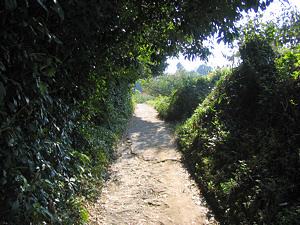 **Introduction.**The Nara Jusan Butsu Pilgrimage covers 13 temples dedicated to the 13 deities of Shingon Buddhism in Nara Prefecture (formerly known as Yamato). Each temple enshrines, or once enshrined, an image of a different deity.
**Introduction.**The Nara Jusan Butsu Pilgrimage covers 13 temples dedicated to the 13 deities of Shingon Buddhism in Nara Prefecture (formerly known as Yamato). Each temple enshrines, or once enshrined, an image of a different deity.
The 13 buddhas and bodhisattvas are Fudo Myo-o, Shaka Nyorai, Monju Bosatsu, Fugen Bosatsu, Jizo Bosatsu, Miroku Bosatsu, Yakushi Nyorai, Kannon Bosatsu, Seishi Bosatsu, Amida Nyorai, Ashuku Nyorai, Dainichi Nyorai and Kokuzo Bosatsu.
Hozanji (#1 Fudo Myo-o) The first temple on the pilgrimage is a short train ride west from Saidaiji ttation, then a 10-minute walk from the central exit of Hozan-ji station to the Ikoma Cable Line and up Mount Ikoma. The temple is at the end of a long flight of stone steps flanked by lanterns and through a large concrete torii. The entrance to the temple courtyard is through a small gate. There's no admission fee but no leaflet either.
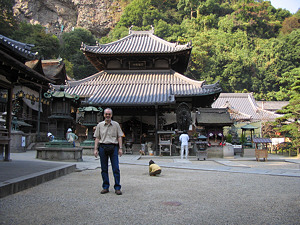 I asked about a pilgrimage book at an office to the left of the gate and they offered me a folding three-part version which can be stood on a shelf as a souvenir. But it was 5,000 yen and would have got bent in my backpack so I took the blue binder type for 1000 yen and a free leaflet in Japanese about the pilgrimage.
I asked about a pilgrimage book at an office to the left of the gate and they offered me a folding three-part version which can be stood on a shelf as a souvenir. But it was 5,000 yen and would have got bent in my backpack so I took the blue binder type for 1000 yen and a free leaflet in Japanese about the pilgrimage.
The temple itself is in a slightly cramped courtyard set against a cliff, with a statue of Kannon standing high up in a recess in the cliff face. The temple is popular because the deity Kankiten (Shoten) is enshrined in its Shotendo Hall. Derived from the elephant-headed Hindu god Ganesh, Kankiten is believed to be a protector of Buddhism and a deity of luck, commerce, amicable marital relationships, having children, and granting people's worldly hopes and desires.
Although the Hozan-ji is the Fudo Myo-o temple of the pilgrimage, the only image of Fudo I could find was a relatively modern one in the courtyard. And for some reason a woman was doing endless circumambulations of the courtyard most of the time I was there. On a higher level I found more buildings and a path lined with Jizo statues leading off into the forest. All in all it's a very pleasant temple to visit, with tall trees and a view of the plain below.
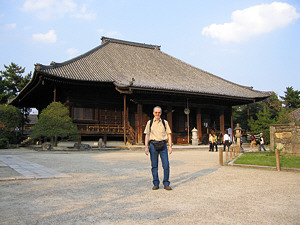 Saidaiji (#2 Shaka) Since it was on the same rail line I headed straight for Saidaiji Temple after leaving Hozanji. To reach the temple compound, take the south exit from Saidaiji station and turn right, then left, then walk straight ahead for a couple of minutes.
Saidaiji (#2 Shaka) Since it was on the same rail line I headed straight for Saidaiji Temple after leaving Hozanji. To reach the temple compound, take the south exit from Saidaiji station and turn right, then left, then walk straight ahead for a couple of minutes.
Completed in 780, Saidaiji was originally a huge temple covering some 48 hectares, but a series of disasters in the Heian period reduced it to a shadow of its former glory and its images were lost. In the middle of the Kamakura period the priest Kosho Bosatsu Eison revived the temple and established it as the main seminary for the Shingon Ritsu sect.
The nokyo (pilgrim's office) in the main hall has an informative two-page leaflet in English. Admission is 400 yen. Inside the hall the atmosphere is magical, with rows of golden lamps on shelves all around and the magificent Seiryoji-style Shaka Nyorai as the principal object of worship. This image was carved by a team of 11 sculptors, including Hokyo and Zenkai, in 1249. On Shakyamuni's right is a large statue of Monju Bosatsu riding a mythical lion, carved in 1302. On his left is a two-metre statue of Miroku Bosatsu reconstructed in 1322 after a fire destroyed the Miroku Hall. Images of Monju are rare and this particular one gave rise to a cult dedicated to the deity.
After contempating these three magnificent sculptures for 20 minutes a noisy tour group entered and I moved to the treasure house to see a statue of Kichijoten (Kisshoten) which the attendant had great difficulty locating and identifying. As is often the case, there were no signs in English.
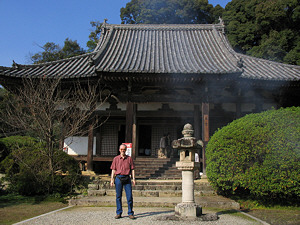 Chogakuji (#3 Fugen) Since Chogakuji is on the Yamanobe-no-Michi path to Miwa, the oldest road in Japan, I decided to walk there. This means taking a train the Tenri station and then a ten-minute taxi ride to Isonokami-jingu shrine. The path starts at the shrine entrance and leads off through the woods to the right, passing several ponds and eventually descending to flat ground and passing through fields and villages. It takes about 80 minutes to reach Chogakuji but it's a very pleasant walk.
Chogakuji (#3 Fugen) Since Chogakuji is on the Yamanobe-no-Michi path to Miwa, the oldest road in Japan, I decided to walk there. This means taking a train the Tenri station and then a ten-minute taxi ride to Isonokami-jingu shrine. The path starts at the shrine entrance and leads off through the woods to the right, passing several ponds and eventually descending to flat ground and passing through fields and villages. It takes about 80 minutes to reach Chogakuji but it's a very pleasant walk.
The temple, with its steep roof and iris pond, is one of the most picturesque on the pilgrimage. There is no image of Fugen on display but the temple's principal image of Amida is the earliest Japanese sculpture to use crystal eyes for added realism. There is also a famous hell screenshown to the public between October 23 and November 30 that I was fortunate enough to see.
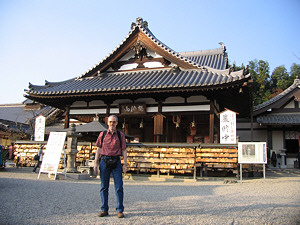 **Abemonjuin (#4 Monju)**Rather than continue walking south to Miwa, I headed west for 20 minutes and caught the train for Sakurai at Yanagimoto station. From Sakurai I took a taxi to Abemonjuin temple and made a note of the route it took. The main hall of the temple isn't much to look at but it does have a beautiful "floating pavillion" on a pond. The people at the temple office made a big fuss over me and I was eventually ushered into a small room with a few other visitors for a delicious cup of macha and a small cake with a pentangle design on the top. The pentangle seems to relate to legendary Yin-Yang Master Abe no Seimei, who may have been born at the temple.
**Abemonjuin (#4 Monju)**Rather than continue walking south to Miwa, I headed west for 20 minutes and caught the train for Sakurai at Yanagimoto station. From Sakurai I took a taxi to Abemonjuin temple and made a note of the route it took. The main hall of the temple isn't much to look at but it does have a beautiful "floating pavillion" on a pond. The people at the temple office made a big fuss over me and I was eventually ushered into a small room with a few other visitors for a delicious cup of macha and a small cake with a pentangle design on the top. The pentangle seems to relate to legendary Yin-Yang Master Abe no Seimei, who may have been born at the temple.
Inside the main hall, the enormous carving of Monju riding a mythical lion is breathtaking. There are very few carvings of Monju in existence and this is one of the most well known. As I entered the hall, some kind of service was in progress with a priest doing some magnificent chanting marred only by the occasional coughing fit. There were two young couples kneeling in front of Monju and the priest was dumping a cloth bag on their heads and saying, "Eum!" Apparently, the temple specialises in ceremonies to prevent dementia, and this was one of them.
Overlooking the temple and pond is a hill from where visitors can look down on a flower arrangement welcoming in the Year of the Pig. Although Abemonjuin is a popular temple, I didn't see any taxis waiting and had to walk for 25 minutes back to the station.
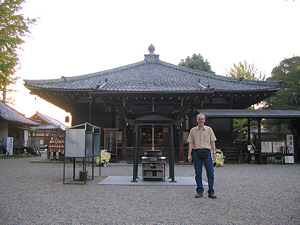 Daianji (#13 Kokuzo) I visited this last temple of the pilgrimage one day because I happened to be in Nara with some free time. It's about 10 minutes due south by taxi from JR Nara station. Daianji was originally one of the Seven Great Temples of Nara, but all its former glory has been lost. What remains is a small hondo and a rather ugly and unattended treasure house. There was no image of Kokuzo on view and the other images were not that inspiring. After a short walk to the main road I was able to catch a bus back to the station.
Daianji (#13 Kokuzo) I visited this last temple of the pilgrimage one day because I happened to be in Nara with some free time. It's about 10 minutes due south by taxi from JR Nara station. Daianji was originally one of the Seven Great Temples of Nara, but all its former glory has been lost. What remains is a small hondo and a rather ugly and unattended treasure house. There was no image of Kokuzo on view and the other images were not that inspiring. After a short walk to the main road I was able to catch a bus back to the station.